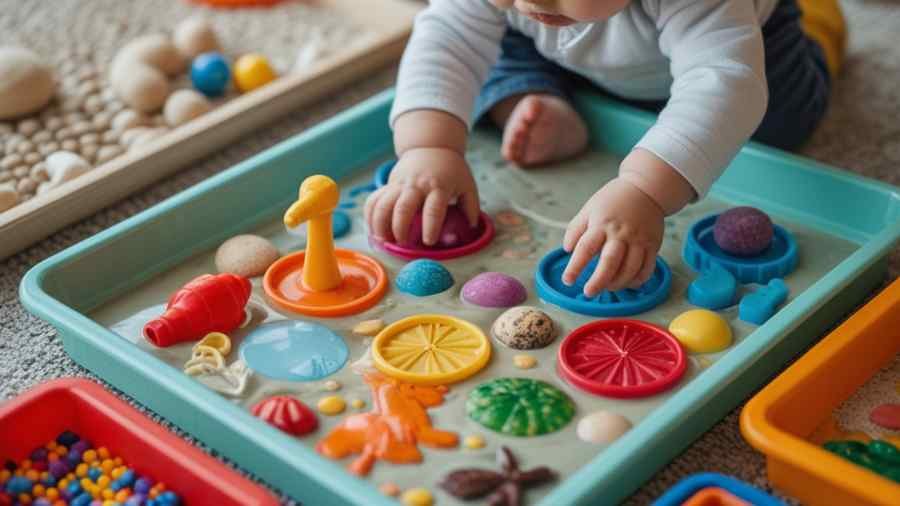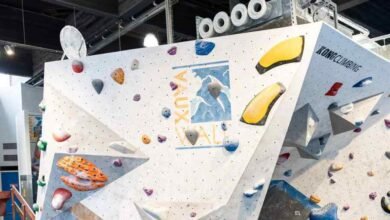Tuff Tray Ideas for Babies: Inspiring Sensory Play Activities for Early Development

Playtime is the foundation of a baby’s learning journey. From the moment they begin to reach, touch, and explore, every movement helps shape their understanding of the world. One of the most creative and engaging tools for encouraging exploration is the tuff tray. Originally used in schools for messy play and group learning, tuff trays have now become a favourite among parents for at-home sensory play. They provide a contained, safe, and easy-to-clean space where babies can discover colours, textures, and patterns while developing essential skills.
What Is a Tuff Tray and Why Use It?
A tuff tray, sometimes called a “builder’s tray” or “activity tray,” is a large, shallow, plastic tray typically used for sensory and messy play. It is designed to contain different materials like sand, water, or sensory toys in one easy-to-clean space.
For babies, tuff trays are especially beneficial because they provide:
- A safe, contained play zone – The raised edges prevent toys and materials from scattering across the floor.
- Opportunities for sensory discovery – Babies can explore textures, colours, and sounds in a controlled way.
- Encouragement of motor skills – Reaching, grasping, and splashing all strengthen coordination and muscle control.
- Cognitive growth – Through hands-on play, babies begin to understand cause and effect and learn to focus.
- Mess control – Parents can manage playtime with minimal cleanup afterwards.
A tuff tray can be used both indoors and outdoors, making it a year-round activity hub for your baby.
How to Prepare a Tuff Tray for Babies
Before diving into specific ideas, preparation is key. Babies explore with their mouths and hands, so safety and cleanliness are top priorities.
Preparation checklist:
- Place the tuff tray flat on the floor to prevent tipping.
- Always stay beside your baby during playtime.
- Use edible or non-toxic materials wherever possible.
- Avoid small items that could pose choking risks.
- Lay a soft mat underneath for extra comfort and easy cleanup.
Once your setup is safe, you can start introducing sensory themes and creative ideas.
1. Edible Sensory Play
Babies often explore by tasting objects, which makes edible play an excellent way to stimulate their senses safely.
Ideas:
- Edible sand – Crush plain cereal, oats, or biscuits to create a sand-like texture. Add spoons and cups for scooping.
- Mashed potato fun – Spread cooled mashed potatoes over the tray and let your baby squish and smear it.
- Yoghurt painting – Mix plain yoghurt with a few drops of natural food colouring and allow your baby to finger paint safely.
Developmental benefits: This type of play enhances tactile exploration, hand-eye coordination, and curiosity without the worry of harmful materials.
2. Water Play Adventure
Water play is timeless, soothing, and full of discovery. It helps babies learn about movement and cause and effect.
Ideas:
- Fill the tuff tray with a shallow layer of lukewarm water.
- Add soft toys, rubber ducks, or floating balls.
- Include small containers or spoons for scooping and pouring.
For extra excitement, you can drop a few ice cubes in and let your baby feel the temperature difference.
Benefits: Water play builds sensory awareness, introduces scientific thinking (“if I splash, water moves”), and strengthens motor skills.
Safety note: Always supervise your baby closely. Even shallow water requires constant attention.
3. Nature Discovery Tray
Bring the outdoors inside with a tray full of nature-inspired materials. Babies can safely experience the textures and smells of natural elements.
Ideas:
- Collect leaves, pine cones, soft grass, or flower petals.
- Place them on the tray for your baby to explore.
- Add gentle background music of birds chirping for an immersive sensory experience.
Benefits: This promotes curiosity, builds an early appreciation for nature, and helps with sensory development. For very young babies, choose smooth, soft items that won’t cause scratches or irritation.
4. Rainbow Colour Play
Colour recognition begins in the first few months of life. A rainbow-themed tuff tray helps introduce vibrant shades in a fun and safe way.
Ideas:
- Use coloured scarves, balls, or ribbons.
- Arrange toys in rainbow order and encourage your baby to reach for different colours.
- For added learning, repeat the colour names aloud as your baby touches them.
Benefits: This boosts visual stimulation, language development, and fine motor coordination. The contrast between bright and soft tones keeps babies visually engaged.
5. Reflective and Light Play
Babies are naturally fascinated by shiny and reflective surfaces. A reflective tuff tray setup enhances visual awareness and promotes self-recognition.
Ideas:
- Line the tray with silver foil, a mirrored mat, or metallic wrapping paper.
- Place safe, large reflective toys or utensils like metal spoons on the tray.
- Allow natural light to bounce off the surfaces for an enchanting effect.
Benefits: Reflective play encourages babies to focus, track movements, and notice their own reflection — a key part of cognitive and emotional growth.
6. Soft Toy Safari
Transform the tuff tray into a mini safari full of plush animals and fabric textures.
Ideas:
- Place soft stuffed animals, fabric leaves, and textured cloths around the tray.
- Encourage your baby to feel the different materials.
- Add animal sounds from a small speaker to make the scene more engaging.
Benefits: This activity nurtures tactile awareness, imagination, and listening skills while being completely safe for babies.
7. Music and Sound Tray
Babies love sound exploration. It helps with auditory development and rhythm recognition.
Ideas:
- Add small, safe rattles, wooden spoons, or soft drums.
- Tap gently to demonstrate different sounds.
- Sing or hum familiar tunes to make it interactive.
Benefits: Encourages auditory curiosity, timing awareness, and parent-baby bonding through shared play.
8. Mini Beach Experience
Recreate the joy of the seaside without leaving home.
Ideas:
- Use edible sand made from crushed cereal or couscous.
- Add large shells, pebbles, or plastic sea creatures.
- Include a tiny bowl of water for splashing.
Benefits: This imaginative play introduces natural textures and stimulates both visual and tactile senses. Babies enjoy the contrast between dry “sand” and cool water.
9. Seasonal and Festive Play
Changing your tuff tray theme according to the season keeps playtime exciting and helps babies learn about time and change.
Ideas:
- Spring: Flowers, grass, and pastel-coloured ribbons.
- Summer: Bright balls, fruit shapes, and water play.
- Autumn: Leaves, pinecones, and orange fabrics.
- Winter: Cotton balls for snow and shiny decorations.
Benefits: Seasonal themes expand your baby’s understanding of the environment and introduce new sensory experiences throughout the year.
10. Bubble and Foam Play
Bubbles are fascinating for babies. Watching them float, pop, and disappear introduces fun science learning.
Ideas:
- Fill the tray with baby-safe foam using a small amount of mild soap and water.
- Blow bubbles over the tray for your baby to catch.
- Add a few waterproof toys for extra excitement.
Benefits: Enhances visual tracking, coordination, and sensory exploration while stimulating curiosity.
11. Treasure Basket Tray
Inspired by Montessori play, this setup encourages independent exploration.
Ideas:
- Gather a mix of safe household items: wooden spoons, large brushes, soft fabric, silicone cups, and teething rings.
- Place them in the tray for your baby to handle freely.
Benefits: Encourages problem-solving, object recognition, and fine motor skills. Babies learn that different materials feel and sound unique.
12. Ice Cube Sensory Play
Introduce babies to temperature and texture with ice.
Ideas:
- Freeze small amounts of water with fruit pieces or coloured food-safe dyes.
- Let your baby feel the cubes melt and slide.
- Keep it short and use a towel for comfort.
Benefits: Builds sensory awareness and introduces early science concepts like melting and temperature change.
Tips for Parents
- Always supervise your baby during play.
- Keep play sessions short — around 10 to 20 minutes depending on age.
- Rotate tray ideas weekly to keep engagement high.
- Clean and disinfect the tray after every session.
- Encourage talking and singing during play to support language growth.
How Tuff Tray Play Supports Development
Each tuff tray activity contributes to multiple areas of a baby’s development:
- Sensory development: Babies engage touch, sight, and hearing in every play session.
- Motor skills: Reaching, grabbing, and moving objects improve coordination.
- Language skills: Naming colours and textures builds early vocabulary.
- Emotional growth: Positive, guided play nurtures confidence and curiosity.
- Social bonding: When parents join in, babies feel secure and loved.
The variety of textures and materials encourages problem-solving and creative thinking from an early age.
Conclusion
Tuff tray play is a simple yet powerful way to nurture your baby’s early learning journey. These trays transform everyday objects into opportunities for discovery, helping babies develop vital sensory and motor skills while having fun. Whether it’s the soothing splash of water, the sparkle of reflective foil, or the squish of edible sand, each experience builds a foundation for curiosity and creativity.



